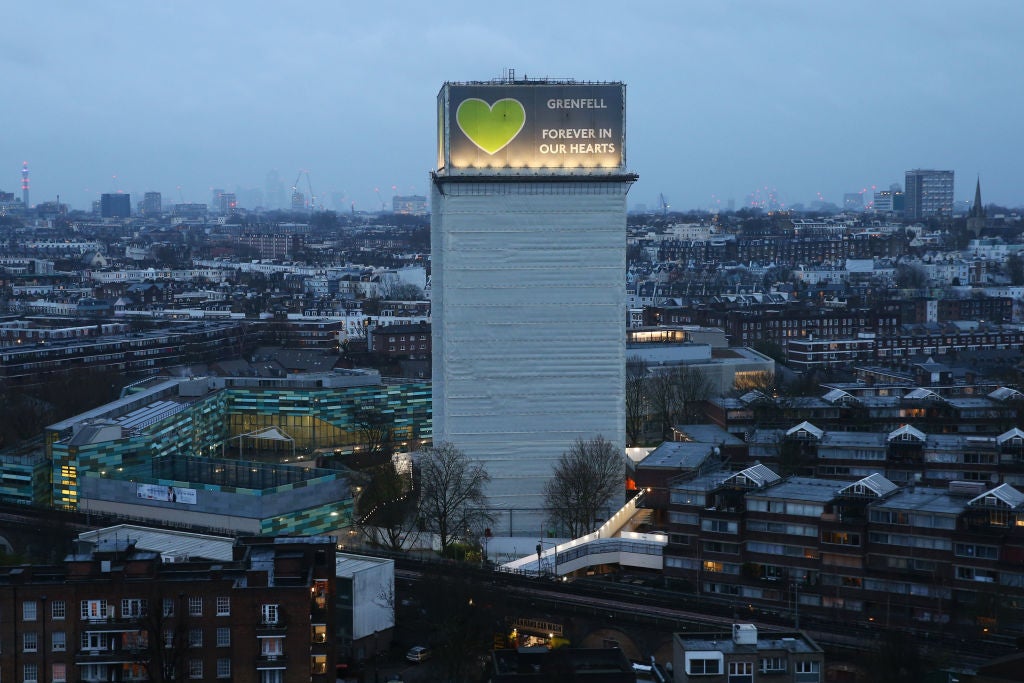Four years on from Grenfell, homeowners caught up in the building safety crisis face financial ruin
Hundreds of thousands of leaseholders are trapped in unsellable, potentially dangerous homes and the government has yet to acknowledge the scale of the problem, writes Ben Chapman


Your support helps us to tell the story
From reproductive rights to climate change to Big Tech, The Independent is on the ground when the story is developing. Whether it's investigating the financials of Elon Musk's pro-Trump PAC or producing our latest documentary, 'The A Word', which shines a light on the American women fighting for reproductive rights, we know how important it is to parse out the facts from the messaging.
At such a critical moment in US history, we need reporters on the ground. Your donation allows us to keep sending journalists to speak to both sides of the story.
The Independent is trusted by Americans across the entire political spectrum. And unlike many other quality news outlets, we choose not to lock Americans out of our reporting and analysis with paywalls. We believe quality journalism should be available to everyone, paid for by those who can afford it.
Your support makes all the difference.Four years on from the Grenfell Tower tragedy, hundreds of thousands of residents in worthless, unsafe flats are dealing with the crushing emotional and financial burden of a building safety crisis that threatens many with losing their homes and bankruptcy.
The government has so far failed to even recognise the scale of the problems, let alone devise a credible plan to fix them, leaving residents feeling helpless and abandoned.
Ralph Glenc, 43, describes his situation as a “nightmare that never ends”. He is stuck in a flat in Kennington Park Square, southeast London, unable to sell his home due to serious fire safety defects which will cost him £25,000 to fix. Others in the development face bills of £60,000.
"This has cost me my job. I had a breakdown last year and I’m receiving antidepressant medication,” he says.
“Over the last few years, all my energy and focus is on surviving and not giving up.”
Glenc’s debts are rising and his flat now looks bare after he had to sell some of his furniture to pay for interim safety measures.
He says he is “furious” that the developer, Barratt Developments, has not taken any responsibility for the problems.
“It’s so unfair that they can continue running their own business operations as if nothing happened, when we had to put our lives on hold. How can you value loss of time, health, opportunities?"
One of Glenc’s neighbours, Anna, is suffering a similarly traumatic time. Each day after school, her 14-year-old daughter waits behind for hours, too afraid to go home alone.
When her mum finishes work at a local supermarket, the two head to the family’s flat. The stress of the pandemic, along with the fear that their home could go up in flames, has left Anna’s daughter suffering from anxiety.
“I’m absolutely terrified for all of our safety. I have worked all through Covid in a supermarket. My anxiety and stress levels are through the roof,” Anna says.
“I’ve had to be far more creative with my food budget – cut back on food and shop around more, we have also had to cut back on electricity.”
She has already had to pay huge bills for fire patrols and alarm systems even before the looming £30,000 charge to fix the work of Barratt and its contractors.
Barratt’s own survey carried out last year shows that the fire safety measures did not meet building regulations, yet the developer has so far not offered to pay.
A Barratt spokesperson said the company was “aware of the difficulties facing leaseholders and residents at Kennington Park Square and appreciate how concerning this must be for them”.
They added that, “while we have no legal liability, we have been working to assess and understand the issues at the development and are committed to working with the managing agent and freeholder to help them find a solution for leaseholders and residents”.
Like many developments, Kennington Park Square was signed off by a building inspector despite being non-compliant when it was constructed in 2009. Even though Barratt’s work was substandard, the company has escaped legal liability which ends six years after a building is completed.
Warranties on new-build homes from the National House Building Council expire after 10 years, leaving blameless leaseholders with no legal route to make a claim. Under the current law, consumers have greater legal protection when buying a household appliance than the home they put it in.
An intrusive survey commissioned in February 2020 confirmed what residents had feared. It revealed a range of shoddy construction work that left the building vulnerable to the kind of blaze that engulfed Grenfell. Their flats were unmortgageable.
While the cladding itself was of “limited combustibility”, the walls were filled with insulation made from phenolic foam, a cheap, commonly used and highly combustible material. It meant that a small electrical fire, of the kind that started in Grenfell Tower four years ago, would have ample fuel to become a raging inferno.
Surveyors also found that cavity barriers – which help keep a fire contained – were defective or missing, so flames could rip through the development’s flats leaving residents little time to save themselves.
If the five buildings that make up Kennington Park Square had been constructed in line with the plans submitted to the local authority they would have complied with fire regulations, but the 2020 survey showed Barratt and its contractors had not stuck to those plans. Corners were cut and different materials used.
The £5bn Building Safety Fund set up by the government to help pay for remediation does not cover most of the defects at Kennington Park Square. It is focused narrowly on cladding. Anything behind the façade of the building is not eligible and residents must pay to fix issues they had no hand in creating.
Around 3,500 buildings above 18 metres may be eligible for government funding while tens of thousands more buildings below that height are thought to have defects similar to those found at Kennington Park Square. The government has said those in the latter category will be able to take out loans with repayments capped at £50 a month. However, no details of how the loan scheme will work in practice have been made public.
Robert Jenrick, the housing secretary, provoked outrage earlier this year when, during a statement on the building safety crisis, he told the House of Commons that he has always worked on the principle of “caveat emptor” – buyer beware.
No buyer of a new-build property in the UK could have known they were being sold a defective product. They have done everything required of them such as having surveys carried out and paying for buildings insurance. None of these experts spotted the problems.
The situation faced by residents at Kennington Park Square is just one example of the unfairness at the heart of the UK’s building safety crisis. The only two parties who can claim to be not at fault – taxpayers and leaseholder – are the ones footing the bill.
Meanwhile a cast of characters with deep pockets lined with the proceeds from two decades of substandard building work look set to walk away with their profits and share prices intact.
Major housebuilders and contractors who did the work, surveyors who signed it off, regulators who allowed dangerous materials to be used, manufacturers of those materials who game the testing system, and insurance companies have all played a role in creating the crisis; but government ministers are inexplicably reluctant to make them pay.
The residents at Kennington Park Square applied months ago for government funding to make their homes safe. They expected to receive a response in December but have had nothing other than a terse rejection letter for one of the buildings which does not qualify for support because it is below 18m.
At the rate the government is currently processing applications it will take years to get through them all. Even when applications are approved, there are not enough workers with the skills required to do the work.
With each day that goes by, homeowners are being drained financially, before any remediation work has even begun. So far they’ve been forced to hand over £450,000 for a so-called waking watch patrol and £150,000 for heat detectors.
Problems are fast approaching a crunch point as bills arrive which residents across the country have no hope of paying.
More than 4 in 10 of the homes in Kennington Park are affordable housing, bought through government-supported shared ownership or through Wandle Housing Association. Many residents cannot pay their share of the estimated £5.9m cost to make their homes safe.
Ralph Glenc believes he will have no choice but to declare himself bankrupt if the government does not step in to pay the bill. “It is not an option for me to pay, there is no way for me to get £25,000.”
For some residents, bankruptcy would threaten their careers. Lawyers, financial services workers and civil servants are among those whose professions bar people who have been declared bankrupt.
Ministers’ approach has been to deny the scale of the problems and claim that the £5bn it has allocated so far is adequate. The claim is unsupported by evidence because the Ministry for Housing Communities and Local Government (MHCLG) has not carried out the work to establish what needs to be done.
As a result, billions of pounds of public funding has been allocated which, by all credible estimates, is not nearly enough. Yet at the same time money is almost certainly being wasted on work that is not a priority or does not need to be carried out at all, because no assessment has been made of the relative risk posed by different buildings.
A toxic mix of incentives is adding to the danger of public money being wasted and leaseholders being handed inflated bills. Managing agents who organise the work and appoint contractors take a percentage cut of the bill.
While the residents at Kennington Park Square say that their managing agent has been generally helpful, for the more unscrupulous agents, the current situation is an opportunity for a once-in-a lifetime fees bonanza.
Companies that own the freeholds to blocks of flats also have a perverse incentive to push for as much refurbishment as they can get away with to boost the value of their investment at no expense to themselves. England’s archaic leasehold law means that flat owners are powerless to fight back.
Campaigners and a growing group of backbench Conservative rebels are demanding a radical change in approach from the government.
Liam Spender, a lawyer who lives in a flat affected by the crisis, says the government could “easily” commit to funding all necessary work up front and then recoup money from developers and others through taxation.
The Leasehold Knowledge Partnership has proposed a levy on builders and foreign buyers to fund works while the mayor of London is calling for a windfall tax on developer profits.
What almost everyone outside of government now agrees on is that the current plan cannot possibly solve the problem.
“What the government is proposing is like constructing a building without putting a roof on it,” says Spender. “It’s doing part of the job when a full job is required.”
Subscribe to Independent Premium to bookmark this article
Want to bookmark your favourite articles and stories to read or reference later? Start your Independent Premium subscription today.
Join our commenting forum
Join thought-provoking conversations, follow other Independent readers and see their replies
Comments